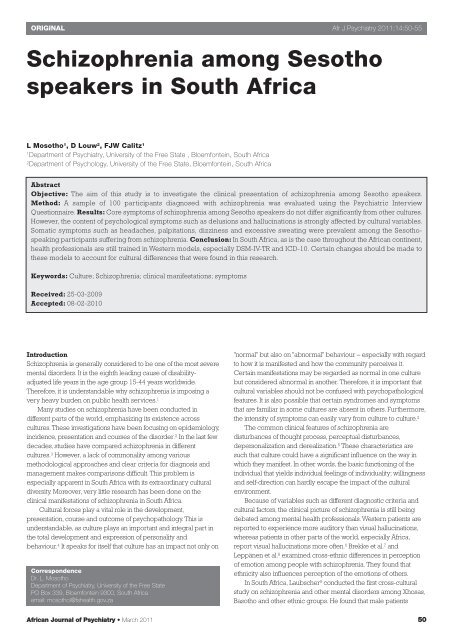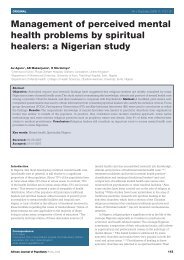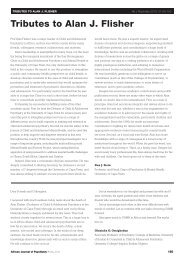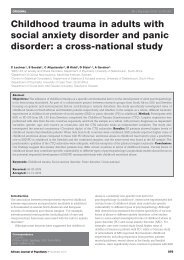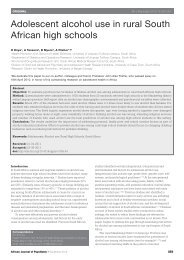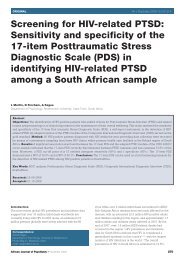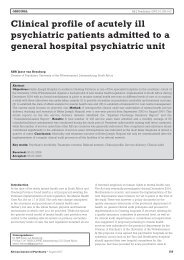Schizophrenia among Sesotho speakers in South Africa 50
Schizophrenia among Sesotho speakers in South Africa 50
Schizophrenia among Sesotho speakers in South Africa 50
You also want an ePaper? Increase the reach of your titles
YUMPU automatically turns print PDFs into web optimized ePapers that Google loves.
ORIGINAL Afr J Psychiatry 2011;14:<strong>50</strong>-55<br />
<strong>Schizophrenia</strong> <strong>among</strong> <strong>Sesotho</strong><br />
<strong>speakers</strong> <strong>in</strong> <strong>South</strong> <strong>Africa</strong><br />
L Mosotho1 , D Louw2 , FJW Calitz1 1Department of Psychiatry, University of the Free State , Bloemfonte<strong>in</strong>, <strong>South</strong> <strong>Africa</strong><br />
2Department of Psychology, University of the Free State, Bloemfonte<strong>in</strong>, <strong>South</strong> <strong>Africa</strong><br />
Abstract<br />
Objective: The aim of this study is to <strong>in</strong>vestigate the cl<strong>in</strong>ical presentation of schizophrenia <strong>among</strong> <strong>Sesotho</strong> <strong>speakers</strong>.<br />
Method: A sample of 100 participants diagnosed with schizophrenia was evaluated us<strong>in</strong>g the Psychiatric Interview<br />
Questionnaire. Results: Core symptoms of schizophrenia <strong>among</strong> <strong>Sesotho</strong> <strong>speakers</strong> do not differ significantly from other cultures.<br />
However, the content of psychological symptoms such as delusions and halluc<strong>in</strong>ations is strongly affected by cultural variables.<br />
Somatic symptoms such as headaches, palpitations, dizz<strong>in</strong>ess and excessive sweat<strong>in</strong>g were prevalent <strong>among</strong> the <strong>Sesotho</strong>speak<strong>in</strong>g<br />
participants suffer<strong>in</strong>g from schizophrenia. Conclusion: In <strong>South</strong> <strong>Africa</strong>, as is the case throughout the <strong>Africa</strong>n cont<strong>in</strong>ent,<br />
health professionals are still tra<strong>in</strong>ed <strong>in</strong> Western models, especially DSM-IV-TR and ICD-10. Certa<strong>in</strong> changes should be made to<br />
these models to account for cultural differences that were found <strong>in</strong> this research.<br />
Keywords: Culture; <strong>Schizophrenia</strong>; cl<strong>in</strong>ical manifestations; symptoms<br />
Received: 25-03-2009<br />
Accepted: 08-02-2010<br />
Introduction<br />
<strong>Schizophrenia</strong> is generally considered to be one of the most severe<br />
mental disorders. It is the eighth lead<strong>in</strong>g cause of disabilityadjusted<br />
life years <strong>in</strong> the age group 15-44 years worldwide.<br />
Therefore, it is understandable why schizophrenia is impos<strong>in</strong>g a<br />
very heavy burden on public health services. 1<br />
Many studies on schizophrenia have been conducted <strong>in</strong><br />
different parts of the world, emphasiz<strong>in</strong>g its existence across<br />
cultures. These <strong>in</strong>vestigations have been focus<strong>in</strong>g on epidemiology,<br />
<strong>in</strong>cidence, presentation and courses of the disorder. 2 In the last few<br />
decades, studies have compared schizophrenia <strong>in</strong> different<br />
cultures. 3 However, a lack of commonality <strong>among</strong> various<br />
methodological approaches and clear criteria for diagnosis and<br />
management makes comparisons difficult. This problem is<br />
especially apparent <strong>in</strong> <strong>South</strong> <strong>Africa</strong> with its extraord<strong>in</strong>ary cultural<br />
diversity. Moreover, very little research has been done on the<br />
cl<strong>in</strong>ical manifestations of schizophrenia <strong>in</strong> <strong>South</strong> <strong>Africa</strong>.<br />
Cultural forces play a vital role <strong>in</strong> the development,<br />
presentation, course and outcome of psychopathology. This is<br />
understandable, as culture plays an important and <strong>in</strong>tegral part <strong>in</strong><br />
the total development and expression of personality and<br />
behaviour. 4 It speaks for itself that culture has an impact not only on<br />
Correspondence<br />
Dr. L. Mosotho<br />
Department of Psychiatry, University of the Free State<br />
PO Box 339, Bloemfonte<strong>in</strong> 9300, <strong>South</strong> <strong>Africa</strong><br />
email: mosothol@fshealth.gov.za<br />
"normal" but also on "abnormal" behaviour – especially with regard<br />
to how it is manifested and how the community perceives it.<br />
Certa<strong>in</strong> manifestations may be regarded as normal <strong>in</strong> one culture<br />
but considered abnormal <strong>in</strong> another. Therefore, it is important that<br />
cultural variables should not be confused with psychopathological<br />
features. It is also possible that certa<strong>in</strong> syndromes and symptoms<br />
that are familiar <strong>in</strong> some cultures are absent <strong>in</strong> others. Furthermore,<br />
the <strong>in</strong>tensity of symptoms can easily vary from culture to culture. 2<br />
The common cl<strong>in</strong>ical features of schizophrenia are<br />
disturbances of thought process, perceptual disturbances,<br />
depersonalization and derealization. 5 These characteristics are<br />
such that culture could have a significant <strong>in</strong>fluence on the way <strong>in</strong><br />
which they manifest. In other words, the basic function<strong>in</strong>g of the<br />
<strong>in</strong>dividual that yields <strong>in</strong>dividual feel<strong>in</strong>gs of <strong>in</strong>dividuality; will<strong>in</strong>gness<br />
and self-direction can hardly escape the impact of the cultural<br />
environment.<br />
Because of variables such as different diagnostic criteria and<br />
cultural factors, the cl<strong>in</strong>ical picture of schizophrenia is still be<strong>in</strong>g<br />
debated <strong>among</strong> mental health professionals. Western patients are<br />
reported to experience more auditory than visual halluc<strong>in</strong>ations,<br />
whereas patients <strong>in</strong> other parts of the world, especially <strong>Africa</strong>,<br />
report visual halluc<strong>in</strong>ations more often. 6 Brekke et al. 7 and<br />
Leppänen et al. 8 exam<strong>in</strong>ed cross-ethnic differences <strong>in</strong> perception<br />
of emotion <strong>among</strong> people with schizophrenia. They found that<br />
ethnicity also <strong>in</strong>fluences perception of the emotions of others.<br />
In <strong>South</strong> <strong>Africa</strong>, Laubscher 9 conducted the first cross-cultural<br />
study on schizophrenia and other mental disorders <strong>among</strong> Xhosas,<br />
Basotho and other ethnic groups. He found that male patients<br />
<strong>Africa</strong>n Journal of Psychiatry • March 2011 <strong>50</strong>
ORIGINAL Afr J Psychiatry 2011;14:<strong>50</strong>-55<br />
especially presented with auditory halluc<strong>in</strong>ations. The<br />
halluc<strong>in</strong>ations of traditional patients were centred on hear<strong>in</strong>g the<br />
voices of ancestors, while Christian patients heard the voice of<br />
God. Visual halluc<strong>in</strong>ations consisted of see<strong>in</strong>g the <strong>Africa</strong>n<br />
equivalent of greml<strong>in</strong>s and gobl<strong>in</strong>s. Tactile halluc<strong>in</strong>ations were often<br />
felt <strong>in</strong>side the female sexual organ, abdomen or throat. Mamlambo<br />
(a halluc<strong>in</strong>ation of a beautiful seductive female at a river or a lake)<br />
was the most common visual halluc<strong>in</strong>ation <strong>among</strong> male<br />
schizophrenic patients. Delusions of poison<strong>in</strong>g were prom<strong>in</strong>ent<br />
<strong>among</strong> female schizophrenic patients, followed by delusions of<br />
bewitchment. Delusions of grandeur <strong>among</strong> females were centred<br />
on own<strong>in</strong>g cattle, land and money, and <strong>among</strong> males on hav<strong>in</strong>g<br />
many herds of cattle, many wives and much money.<br />
A few other cross-cultural studies on schizophrenia have been<br />
conducted s<strong>in</strong>ce Laubscher's study. In Cape Town (<strong>South</strong> <strong>Africa</strong>),<br />
and W<strong>in</strong>dhoek (Namibia), Maslowski et al. 10 <strong>in</strong>vestigated the<br />
differences <strong>in</strong> symptoms of schizophrenia <strong>among</strong> different cultural<br />
and ethnic groups. The groups were composed of the coloured<br />
population of Cape Town and black patients from W<strong>in</strong>dhoek.<br />
Variations <strong>in</strong> symptoms of schizophrenia were detected, which<br />
were primarily attributed to differences <strong>in</strong> culture. The<br />
halluc<strong>in</strong>ations experienced by black patients centred on hear<strong>in</strong>g<br />
the voices of traditional healers and animals, while the coloured<br />
sample heard the voices of very important people like politicians.<br />
Both groups developed delusions of persecution founded on their<br />
racial diversity, especially hatred or fear between the two groups.<br />
This could be ascribed to the history of <strong>South</strong> <strong>Africa</strong> and Namibia<br />
where, <strong>in</strong> the past, coloureds and blacks were racially, culturally<br />
and geographically separated by the system. The coloured group<br />
manifested a more restricted affect than the black participants.<br />
In Cape Town, Ens<strong>in</strong>k et al. 11 <strong>in</strong>vestigated the ways <strong>in</strong> which<br />
schizophrenia is manifested <strong>among</strong> black Xhosa <strong>speakers</strong><br />
compared to white English <strong>speakers</strong>. The f<strong>in</strong>d<strong>in</strong>gs were that<br />
Xhosa-speak<strong>in</strong>g patients had marked behavioural disturbances,<br />
particularly aggression and disruptive behaviour. The Xhosa<br />
patients also scored high on irritability and hysteria compared to<br />
white patients. Delusions of persecution, poor self-care, sexual and<br />
fantastic delusions were significantly more common <strong>among</strong> Xhosaspeak<strong>in</strong>g<br />
than <strong>among</strong> white patients. Mood symptoms, specifically<br />
symptoms of depression, were reported more by white patients<br />
than by Xhosa patients.<br />
It should be noted, however, that several other schizophrenialike<br />
syndromes have also been reported <strong>in</strong> <strong>South</strong> <strong>Africa</strong>. For<br />
example, some of the most common forms of these syndromes are<br />
amafufunyana and ukuthwasa, which have been reported<br />
especially <strong>among</strong> Zulus and Xhosas. 12 These culture-bound<br />
syndromes are sometimes used to describe the cl<strong>in</strong>ical features of<br />
serious mental illness such as schizophrenia.<br />
Aga<strong>in</strong>st this background, the aim of the study was to <strong>in</strong>vestigate<br />
the manifestation of schizophrenia <strong>among</strong> <strong>Sesotho</strong> <strong>speakers</strong> <strong>in</strong><br />
Mangaung, Free State Prov<strong>in</strong>ce, <strong>South</strong> <strong>Africa</strong>.<br />
Method<br />
The participants consisted of 100 <strong>Sesotho</strong> <strong>speakers</strong> diagnosed<br />
with <strong>Schizophrenia</strong> from Mangaung Township <strong>in</strong> Bloemfonte<strong>in</strong>,<br />
<strong>South</strong> <strong>Africa</strong>. They were drawn from consecutive patients<br />
diagnosed with schizophrenia present<strong>in</strong>g at various health<br />
establishments <strong>in</strong> the area. The participants were evaluated and<br />
diagnosed by a multi-professional team. The DSM-IV-TR criteria for<br />
schizophrenia were used as the <strong>in</strong>clusion criteria. The participants<br />
were between 18 and 65 years of age, and both genders were<br />
represented. Written <strong>in</strong>formed consent was obta<strong>in</strong>ed from each<br />
participant.<br />
A semi-structured <strong>in</strong>terview, based on the Psychiatric Interview<br />
Questionnaire (PIQ) used by the Department of Psychiatry at the<br />
University of the Free State, was used to elicit the data. The PIQ is<br />
based on Cl<strong>in</strong>ician’s Thesaurus: The Guide for Writ<strong>in</strong>g<br />
Psychological Reports 13 and Outl<strong>in</strong>e of Psychiatric History and<br />
Mental Status Exam<strong>in</strong>ation. 14 The PIQ provides data such as the<br />
history and present manifestation of the disorder(s) as determ<strong>in</strong>ed<br />
by a mental status exam<strong>in</strong>ation consist<strong>in</strong>g of appearance, attitude<br />
and behaviour, thought processes, perception, mood and affect,<br />
consciousness, orientation, memory, tempo, <strong>in</strong>telligence, mode of<br />
th<strong>in</strong>k<strong>in</strong>g, judgement and <strong>in</strong>sight, and hypothalamic and autonomic<br />
function<strong>in</strong>g. 15<br />
Qualitative methods were used to describe the participants’<br />
experiences of their symptoms and to elucidate the quantitative<br />
data. Qualitative methods that were used consisted of two types of<br />
data collection: the open-ended <strong>in</strong>terview and cl<strong>in</strong>ical observation.<br />
The <strong>in</strong>terview data consist of direct quotations from participants<br />
about their experiences, feel<strong>in</strong>gs, emotions, op<strong>in</strong>ions and<br />
knowledge, while observation data refer to detailed descriptions of<br />
participant’s activities, behaviours, actions and the full range of<br />
<strong>in</strong>terpersonal <strong>in</strong>teractions and organisational processes that are<br />
part of observable human experience. 16 Quantitatively, a<br />
descriptive statistical analysis was performed to provide<br />
<strong>in</strong>dications of frequency (prevalence for identify<strong>in</strong>g sociodemographic<br />
characteristics, signs and symptoms of mental<br />
illness, as well as socio-cultural variables associated with<br />
schizophrenia as conta<strong>in</strong>ed <strong>in</strong> the questionnaire.<br />
A pilot study <strong>in</strong>volv<strong>in</strong>g 40 patients was conducted to <strong>in</strong>vestigate<br />
the practical feasibility of the research. Based on the pilot study<br />
f<strong>in</strong>d<strong>in</strong>gs, certa<strong>in</strong> adjustments were made to the cod<strong>in</strong>g of the<br />
questionnaire. The study was approved by the Ethics Committee<br />
and the Council of the University of the Free State.<br />
Results and Discussion<br />
Editor’s note- results and discussion are not typically presented<br />
<strong>in</strong> an <strong>in</strong>tegrated manner but on this occasion it was permitted<br />
The socio-demographic characteristics of the participants are<br />
presented <strong>in</strong> Table I.<br />
Just over fifty percent of the sample was aged between 26 and<br />
45 years. These f<strong>in</strong>d<strong>in</strong>gs correspond with a claim by Häfner and An<br />
der Heiden 17 that schizophrenia is ma<strong>in</strong>ly a disease of adolescence<br />
and early adulthood, and their f<strong>in</strong>d<strong>in</strong>gs that the average age at first<br />
contact with mental health services is between 25 and 35 of age for<br />
both females and males. Similarly, Le Roux et al. 18 reported that the<br />
mean age of onset of schizophrenia <strong>among</strong> Xhosa-speak<strong>in</strong>g<br />
patients was 23.14, mean<strong>in</strong>g that it ranges between 14 and 51<br />
years. Male participants <strong>in</strong> the present study largely outnumbered<br />
females. Possible reasons for this disparity are that women tend to<br />
have a better prognosis and more favourable course of<br />
schizophrenia compared to their male counterparts. They also<br />
tend to develop fewer negative symptoms (reflect<strong>in</strong>g a dim<strong>in</strong>ution<br />
or loss of normal functions) and good social adjustment. 19,20 The<br />
result is that they experience fewer hospitalizations and are<br />
<strong>in</strong>cl<strong>in</strong>ed to short-term stays as <strong>in</strong>-patients, which makes them less<br />
available for research projects.<br />
The educational levels of the participants are not surpris<strong>in</strong>g.<br />
Less than 5% had qualifications higher than Grade 12. Though<br />
<strong>South</strong> <strong>Africa</strong> is a develop<strong>in</strong>g country; these f<strong>in</strong>d<strong>in</strong>gs are more or<br />
less <strong>in</strong> agreement with the situation <strong>in</strong> more developed countries<br />
<strong>Africa</strong>n Journal of Psychiatry • March 2011 51
ORIGINAL Afr J Psychiatry 2011;14:<strong>50</strong>-55<br />
Table I: Socio-demographic characteristics of the<br />
participants<br />
Characteristics % of the sample<br />
Age<br />
18 – 25 14,0<br />
26 – 35 26,0<br />
36 – 45 27,0<br />
46 – 55 19,0<br />
56 – 65 14,0<br />
Gender<br />
Male 58,0<br />
Female 42,0<br />
Education<br />
None 7,1<br />
Grades 1 – 4 21,4<br />
Grades 5 – 7 34,7<br />
Grades 8 – 10 20,4<br />
Grades 11 – 12 10,2<br />
Grades 12 Plus 4,2<br />
Other 2,0<br />
Marital Status<br />
S<strong>in</strong>gle 62,0<br />
Married 16,0<br />
Separated 4,0<br />
Divorced 8,0<br />
Widowed 5,0<br />
Cohabitation 5,0<br />
Employment and occupation<br />
Formally employed 7,0<br />
Informally employed 2,0<br />
Pensioner 1,0<br />
Disability grant 65,0<br />
Students 5,0<br />
Hous<strong>in</strong>g<br />
Shack (<strong>in</strong>formal settlement) 41,4<br />
House / part of a house 56,6<br />
Outbuild<strong>in</strong>gs 2,2<br />
Social support system<br />
Both parents 9,1<br />
S<strong>in</strong>gle mother 24,2<br />
S<strong>in</strong>gle father 2,0<br />
Step-parent(s) 1,0<br />
Foster-parent(s) 3,0<br />
Grandparents 8,1<br />
Alone 14,1<br />
Stay<strong>in</strong>g with other relatives 28,3<br />
Stay<strong>in</strong>g with friends 10,1<br />
Substance abuse<br />
Cannabis 29,0<br />
Alcohol 57,0<br />
Nicot<strong>in</strong>e 55,0<br />
Snuff (<strong>in</strong>halants) 19,0<br />
* It should be taken <strong>in</strong>to account that some frequencies may not add up to<br />
100% because the <strong>in</strong>formation on a small (<strong>in</strong>significant) number of the<br />
participants was neither available nor adequate.<br />
such as the USA, the Czech Republic and Japan 21 , while it is <strong>in</strong><br />
strong contrast with f<strong>in</strong>d<strong>in</strong>gs <strong>in</strong> some develop<strong>in</strong>g countries such as<br />
Nigeria and India. 2,21<br />
The majority of the participants were never married. Bhugra et<br />
al. 22 reported the same trend <strong>among</strong> <strong>Africa</strong>n-Caribbeans suffer<strong>in</strong>g<br />
from schizophrenia <strong>in</strong> London. Most of the participants were<br />
unemployed, liv<strong>in</strong>g on public assistance known as a disability grant<br />
provided by the Government. The f<strong>in</strong>d<strong>in</strong>g is supported by<br />
Mohlahle et al. 23 who reported that 80% of the patients suffer<strong>in</strong>g<br />
from schizophrenia <strong>in</strong> the Free State were unemployed. The same<br />
trend (80%) was reported with regard to the Cape Town <strong>in</strong> <strong>South</strong><br />
<strong>Africa</strong>. 24<br />
More than half of the participants stay <strong>in</strong> a house, or part of a<br />
house, while 41.4 % live <strong>in</strong> <strong>in</strong>formal hous<strong>in</strong>g. Compared to this,<br />
only 18.2% of the Free State population live <strong>in</strong> <strong>in</strong>formal hous<strong>in</strong>g. 25 A<br />
study <strong>among</strong> people with serious mental illness found that<br />
cognitive function<strong>in</strong>g could be <strong>in</strong>fluenced by the type of hous<strong>in</strong>g. 26<br />
They also found socially isolat<strong>in</strong>g hous<strong>in</strong>g to be associated with<br />
weakened executive function<strong>in</strong>g.<br />
More than 80% of the participants had a social support system;<br />
that is, they live with family members, relatives and friends. Many<br />
researchers, <strong>in</strong>clud<strong>in</strong>g the study of the WHO <strong>in</strong> ten countries 2 , have<br />
stressed the significance of social support system which is<br />
reportedly available <strong>in</strong> the develop<strong>in</strong>g world. For example, Dani<br />
and Thienhaus 27 found and stated that schizophrenic patients <strong>in</strong><br />
develop<strong>in</strong>g countries have a better prognosis and course than<br />
those <strong>in</strong> developed nations because of a good social support<br />
system.<br />
The high <strong>in</strong>cidence of persons abus<strong>in</strong>g substances such as<br />
cannabis, alcohol and <strong>in</strong>halants is a concern, as this could have a<br />
negative impact on the course and prognosis of the illness. It has<br />
been reported that an <strong>in</strong>creased risk of crime and violence is<br />
associated with substance-<strong>in</strong>duced psychoses and with<br />
schizophrenia coexist<strong>in</strong>g with substance abuse. 28 Soyka 29 stated<br />
that patients with schizophrenia and comorbidity of substance<br />
abuse exhibit significant differences compared to patients with<br />
schizophrenia alone. The most significant difference is that patients<br />
with both diagnoses comply poorly with treatment. Consequently,<br />
they experience a high rate of relapse and re-admissions.<br />
The f<strong>in</strong>d<strong>in</strong>gs with regard to family history of mental disorders<br />
are displayed <strong>in</strong> Figure 1. The criteria for <strong>in</strong>clusion were severe<br />
disorders such as psychotic disorders, mood disorders and anxiety<br />
disorders. Relatively mild disorders such as nicot<strong>in</strong>e abuse and<br />
Figure 1: Family History of Mental Disorders<br />
<strong>Africa</strong>n Journal of Psychiatry • March 2011 52
ORIGINAL Afr J Psychiatry 2011;14:<strong>50</strong>-55<br />
learn<strong>in</strong>g disorders were not <strong>in</strong>cluded.<br />
More than <strong>50</strong>% of the sample <strong>in</strong>dicated that either close or<br />
distant relatives had been diagnosed with one or more mental<br />
disorders, not necessarily schizophrenia, though <strong>in</strong> many cases the<br />
specific diagnoses of such mental disorders were not known.<br />
These results confirm the thesis that risk for the development of<br />
mental disorders such as schizophrenia <strong>in</strong> close relatives of the<br />
affected <strong>in</strong>dividuals is higher than <strong>in</strong> the general population. 30,31<br />
The f<strong>in</strong>d<strong>in</strong>gs concern<strong>in</strong>g primary symptoms are presented <strong>in</strong><br />
Table II. The <strong>in</strong>clusion criteria for classify<strong>in</strong>g symptoms as primary<br />
revealed a prevalence rate of at least 20%. The researchers<br />
realized that divid<strong>in</strong>g symptoms <strong>in</strong>to physical, psychological and<br />
behavioural categories could be regarded as overlapp<strong>in</strong>g and<br />
superficial. However, for practical and discussion purposes, it was<br />
decided to categorize the symptoms <strong>in</strong>to primary symptoms<br />
(prevalence of 20% and more) and secondary symptoms (less<br />
than 20%, but more than 5%). The frequencies are the sum total of<br />
the symptoms reported by the participants and those identified by<br />
the researcher.<br />
In general, the f<strong>in</strong>d<strong>in</strong>gs of the present study <strong>in</strong>dicate that the<br />
prevalence of positive symptoms of schizophrenia such as<br />
delusions, halluc<strong>in</strong>ations, disorganized behaviour and speech, as<br />
well as negative symptoms, corresponds with f<strong>in</strong>d<strong>in</strong>gs <strong>in</strong> other<br />
cultures. It is also <strong>in</strong> agreement with the study of Niehaus et al. 32<br />
that arrived at similar f<strong>in</strong>d<strong>in</strong>gs <strong>among</strong> Xhosas <strong>in</strong> the Eastern and<br />
Western Cape prov<strong>in</strong>ces <strong>in</strong> <strong>South</strong> <strong>Africa</strong>.<br />
The most prom<strong>in</strong>ent symptoms experienced by the<br />
participants (<strong>50</strong>% and more) were auditory halluc<strong>in</strong>ations followed<br />
by visual halluc<strong>in</strong>ations, delusions, anxiety, poor judgement, poor<br />
concentration, poor libido and a concrete mode of thought. These<br />
f<strong>in</strong>d<strong>in</strong>gs on both auditory and visual halluc<strong>in</strong>ations are <strong>in</strong><br />
accordance with the f<strong>in</strong>d<strong>in</strong>gs of Koen et al. 33 who reported a similar<br />
picture <strong>among</strong> Xhosa-speak<strong>in</strong>g patients <strong>in</strong> Cape Town. However, it<br />
was found that the content of halluc<strong>in</strong>ations and delusions was<br />
affected by cultural variables. The content of auditory<br />
halluc<strong>in</strong>ations was ma<strong>in</strong>ly centred on hear<strong>in</strong>g voices of people,<br />
especially those of ancestors, and undef<strong>in</strong>ed sounds. Visual and<br />
olfactory halluc<strong>in</strong>ations ma<strong>in</strong>ly consisted of see<strong>in</strong>g ancestors and<br />
wild animals, and smell<strong>in</strong>g rotten materials and muti (traditional<br />
medic<strong>in</strong>e) respectively. The delusions were not always<br />
systematized. Some content aspects were related to political<br />
issues, like be<strong>in</strong>g the state president or be<strong>in</strong>g associated with<br />
prom<strong>in</strong>ent political figures. There were also delusions of<br />
Table II: Primary symptoms expressed by <strong>Sesotho</strong> <strong>speakers</strong><br />
Symptoms (%) Symptoms (%)<br />
Auditory halluc<strong>in</strong>ations 90,0 Poor libido 59,0<br />
Concrete mode of th<strong>in</strong>k<strong>in</strong>g 74,0 Insomnia 55,0<br />
Poor concentration/attention 68,0 Dizz<strong>in</strong>ess 47,0<br />
Delusions of persecution 67,0 Excessive sweat<strong>in</strong>g 39,0<br />
Poor judgment 54,0 Headaches 39,0<br />
Visual halluc<strong>in</strong>ations 52,5 Palpitations 39,0<br />
Poor <strong>in</strong>sight 43,0 Constipation 29,0<br />
Blunted affect 43,0 Poor appetite 22,0<br />
Poor memory 34,0 Anxiousness 64,0<br />
Paranoid ideas 28,0 Aggressive behaviour 23,0<br />
Depersonalization 26,9 Suicide ideation 23,0<br />
Anhedonia 26,0 Poverty of speech 23,0<br />
Irrelevant answers 26,0 Olfactory halluc<strong>in</strong>ations 20,0<br />
Irritability 25,0<br />
grandiosity such as hav<strong>in</strong>g much money, be<strong>in</strong>g an important<br />
member of society, and delusions of be<strong>in</strong>g loved by many women.<br />
Also expressed were thought <strong>in</strong>sertion, thought broadcast, thought<br />
withdrawal and persecutory delusions with a theme of<br />
bewitchment.<br />
Headaches, palpitations, dizz<strong>in</strong>ess, constipation and excessive<br />
sweat<strong>in</strong>g were the most prevalent somatic compla<strong>in</strong>ts <strong>among</strong> the<br />
participants. Although little is known about the prevalence of<br />
physical compla<strong>in</strong>ts <strong>among</strong> people suffer<strong>in</strong>g from schizophrenia, <strong>in</strong><br />
a study compar<strong>in</strong>g psychiatric symptoms between Anglo-<br />
Americans and Mexican-Americans, Weisman et al. 34 found that<br />
Mexican-Americans compla<strong>in</strong>ed more about somatic symptoms<br />
than their Anglo-American counterparts. In his study of factors<br />
attributed to somatisation <strong>in</strong> schizophrenia patients, Ritsner 35<br />
concluded that somatic compla<strong>in</strong>ts <strong>among</strong> schizophrenia sufferers<br />
are prevalent and l<strong>in</strong>ked to emotional distress attributed to many<br />
factors such as psychopathology itself, neuroleptic side-effects and<br />
expressed emotions by family members.<br />
Another noteworthy f<strong>in</strong>d<strong>in</strong>g <strong>in</strong> this study was the degree of<br />
suicide risk <strong>among</strong> participants suffer<strong>in</strong>g from schizophrenia<br />
(suicidal ideation was expressed by 23% of the participants). It has<br />
been reported that 10% to 13% of patients suffer<strong>in</strong>g from<br />
schizophrenia commit suicide. 31 In a comparative study of<br />
<strong>in</strong>dividuals with a diagnosis of a broad spectrum of schizophrenia<br />
who had attempted suicide and those who had not, Harkavy-<br />
Friedman et al. 36 found that 33% of their study participants had<br />
attempted suicide at least once. Explor<strong>in</strong>g the possible role<br />
command auditory halluc<strong>in</strong>ations play <strong>in</strong> the development of<br />
suicidal behaviour, Harkavy-Friedman et al. 37 reported that only<br />
8% of their participants stated that they had attempted suicide <strong>in</strong><br />
response to halluc<strong>in</strong>ations. In the present study, the high risk of<br />
suicide behaviour could be attributed probably to the high<br />
prevalence of symptoms of depression and substance abuse.<br />
Catatonic behaviour <strong>among</strong> <strong>Sesotho</strong> <strong>speakers</strong> with<br />
schizophrenia was rare. Only two out of a 100 participants <strong>in</strong> this<br />
study presented with catatonic behaviour. This f<strong>in</strong>d<strong>in</strong>g is consistent<br />
with the outcomes of a study by Al-Issa 38 , who found that <strong>in</strong> Algeria,<br />
an <strong>Africa</strong>n country with strong Arab and Muslim cultures, there was<br />
a low prevalence of the catatonic type of schizophrenia. On the<br />
other hand, this f<strong>in</strong>d<strong>in</strong>g differs from f<strong>in</strong>d<strong>in</strong>gs of other researchers<br />
like Chandrasena 39 , who reported a relatively higher <strong>in</strong>cidence of<br />
catatonia <strong>in</strong> develop<strong>in</strong>g countries than developed ones, especially<br />
<strong>in</strong> <strong>Africa</strong> and Asia. The participants <strong>in</strong> the present study also<br />
displayed marked behavioural disturbances like gross disruption<br />
and aggression. Ens<strong>in</strong>k et al. 11 found a similar trend <strong>among</strong> black<br />
Although it is sometimes difficult to differentiate between<br />
negative symptoms of schizophrenia and depressive symptoms, <strong>in</strong><br />
the present study, the frequency of signs and symptoms of<br />
depression was significantly notable <strong>among</strong> the participants, be<strong>in</strong>g<br />
57%. Matete et al. 40 stated that the subject of depressive symptoms<br />
<strong>in</strong> schizophrenia has been neglected as a field of study. It is<br />
reported that symptoms of depression <strong>in</strong> schizophrenia, especially<br />
dur<strong>in</strong>g the first episode, are between 7% and 70%. At Mapperley<br />
Hospital, House et al. 41 conducted a study on the prevalence of<br />
depression <strong>among</strong> patients suffer<strong>in</strong>g from a first episode of<br />
schizophrenia. They found the prevalence rate of depression<br />
ranged from 22% to 30%. The frequency of irritability and poor<br />
memory co<strong>in</strong>cides with the f<strong>in</strong>d<strong>in</strong>gs by Ens<strong>in</strong>k et al. 11 who<br />
reported a similar trend <strong>among</strong> Xhosa-speak<strong>in</strong>g patients with<br />
schizophrenia and the culture-bound syndrome known as<br />
amafufunyana.<br />
<strong>Africa</strong>n Journal of Psychiatry • March 2011 53
ORIGINAL Afr J Psychiatry 2011;14:<strong>50</strong>-55<br />
In this study, it was also found that signs such as aggression,<br />
walk<strong>in</strong>g around naked, changes <strong>in</strong> physical appearance and poor<br />
personal hygiene were described as possible warn<strong>in</strong>g <strong>in</strong>dicators<br />
of schizophrenia-related illness. Affective, somatic and autonomic<br />
symptoms, as well as substance abuse, seemed to be notable<br />
<strong>among</strong> <strong>Sesotho</strong> <strong>speakers</strong> suffer<strong>in</strong>g from schizophrenia.<br />
The specific health service providers the participants used for<br />
treatment of their illnesses are shown <strong>in</strong> Figure 2.<br />
It is <strong>in</strong>terest<strong>in</strong>g that almost the same high number of <strong>Sesotho</strong><br />
<strong>speakers</strong> suffer<strong>in</strong>g from schizophrenia (nearly 90%) consulted<br />
both Western-tra<strong>in</strong>ed health professionals and traditional/spiritual<br />
healers. The present study confirms the important role traditional<br />
medic<strong>in</strong>e plays <strong>in</strong> mental health services <strong>in</strong> the Free State Prov<strong>in</strong>ce.<br />
There are ongo<strong>in</strong>g debates and discussions <strong>in</strong> <strong>South</strong> <strong>Africa</strong> on the<br />
role, policies and legislation that perta<strong>in</strong>s to traditional medic<strong>in</strong>e.<br />
The World Health Organisation 42 has called on <strong>Africa</strong>n<br />
governments officially to recognize traditional medic<strong>in</strong>e and to<br />
<strong>in</strong>tegrate it <strong>in</strong>to their national health systems. The WHO argues that,<br />
for many centuries, traditional medic<strong>in</strong>e has played an important<br />
role <strong>in</strong> combat<strong>in</strong>g multiple and complex health conditions affect<strong>in</strong>g<br />
<strong>Africa</strong>ns. Because of the popularity, accessibility and affordability of<br />
traditional medic<strong>in</strong>e, more than 80% of the people <strong>in</strong> the region still<br />
cont<strong>in</strong>ue to rely on it for their health-care needs. The reason why<br />
more participants rather consulted psychiatrists than psychologists<br />
could be the fact that the ma<strong>in</strong>stay of treatment for schizophrenia is<br />
antipsychotic drugs and the m<strong>in</strong>ority of patients will be referred for<br />
Cognitive Behaviour Therapy or other appropriate psychological<br />
<strong>in</strong>terventions.<br />
Conclusion<br />
The present study confirms the f<strong>in</strong>d<strong>in</strong>gs of other <strong>in</strong>ternational<br />
researchers that schizophrenia as an illness does exist across<br />
cultures. Although core symptoms of schizophrenia, such as<br />
perceptual disturbances, thought process disorders and<br />
behavioural signs and symptoms, do not vary significantly crossculturally,<br />
it is important to mention that a marked cultural <strong>in</strong>fluence<br />
is play<strong>in</strong>g a role <strong>in</strong> shap<strong>in</strong>g these symptoms, particularly the<br />
content of delusions and halluc<strong>in</strong>ations. It was also revealed that<br />
cl<strong>in</strong>ical manifestations of schizophrenia, which vary from <strong>in</strong>dividual<br />
to <strong>in</strong>dividual with<strong>in</strong> the same cultural group<strong>in</strong>g, imply that<br />
emphasis should not only be put on general cultural similarities,<br />
but also on <strong>in</strong>dividual differences.<br />
Another <strong>in</strong>terest<strong>in</strong>g aspect of this study is the f<strong>in</strong>d<strong>in</strong>g that the<br />
majority of the participants, similar to f<strong>in</strong>d<strong>in</strong>gs of other <strong>in</strong>ternational<br />
studies, were never married. Nonetheless, the majority of those<br />
patients enjoyed great social support systems <strong>in</strong> that more than<br />
80% of them were not liv<strong>in</strong>g or stay<strong>in</strong>g alone. It has been stated<br />
frequently that patients <strong>in</strong> the develop<strong>in</strong>g world do boast a better<br />
course and prognosis on several measures than patients <strong>in</strong><br />
developed countries. Although schizophrenia places a very heavy<br />
burden on the country’s budget and health services, its<br />
consequences are better dealt with <strong>in</strong> the Third World due to the<br />
availability of social support systems.<br />
As far as the treatment of schizophrenia is concerned, the<br />
approach taken by <strong>Sesotho</strong> <strong>speakers</strong> is similar to other fellow<br />
<strong>Africa</strong>ns <strong>in</strong> the sub-Saharan regions and other parts of <strong>South</strong> <strong>Africa</strong><br />
<strong>in</strong> particular. Traditional medic<strong>in</strong>e is usually the first choice of<br />
treatment, followed by the Western approach or the simultaneous<br />
comb<strong>in</strong>ation of the two. <strong>Africa</strong>n authors argue that mental health<br />
care <strong>in</strong> <strong>Africa</strong> has been <strong>in</strong> the hands of both traditional and spiritual<br />
healers for many centuries. The argument is that <strong>Africa</strong>n<br />
Figure 2: Health service providers consulted by participants<br />
knowledge can offer and contribute much to Western science, and<br />
vice versa. These two worlds should not negate but rather<br />
complement each other.<br />
In <strong>South</strong> <strong>Africa</strong>, as is the case throughout the <strong>Africa</strong>n cont<strong>in</strong>ent,<br />
health professionals are still tra<strong>in</strong>ed <strong>in</strong> Western models, especially<br />
DSM-IV-TR and ICD-10. Adjustments to these models should be<br />
made to account for cultural differences that were found <strong>in</strong> this and<br />
other studies. This does not mean that the proverbial baby should<br />
be thrown out with the bathwater, but rather that an <strong>in</strong>tegration of<br />
the Western model and the non-Western cultural viewpo<strong>in</strong>ts. Such<br />
<strong>in</strong>tegration should meet the needs of both the Western and non-<br />
Western population groups <strong>in</strong> <strong>South</strong> <strong>Africa</strong>.<br />
Although this study has revealed significant f<strong>in</strong>d<strong>in</strong>gs, these<br />
results should be <strong>in</strong>terpreted with care, particularly as far as<br />
generalization is concerned. The concern largely applies to the<br />
locality of research because the patients were almost exclusively<br />
from one area of the Free State Prov<strong>in</strong>ce, while <strong>Sesotho</strong> <strong>speakers</strong><br />
are widely dispersed throughout the prov<strong>in</strong>ce, other parts of <strong>South</strong><br />
<strong>Africa</strong> and Lesotho. Another factor for consideration is that there<br />
are many sub-cultural differences with<strong>in</strong> the population of <strong>Sesotho</strong><br />
<strong>speakers</strong>. However, the study rema<strong>in</strong>s significant because it does<br />
not only contribute to important academic data <strong>in</strong> a field that has<br />
been largely neglected <strong>in</strong> <strong>South</strong> <strong>Africa</strong>, but also provides<br />
<strong>in</strong>formation on demographic and socio-cultural factors associated<br />
with schizophrenia <strong>among</strong> <strong>Sesotho</strong> <strong>speakers</strong>. This research will<br />
contribute to improv<strong>in</strong>g the reliability of diagnos<strong>in</strong>g schizophrenia<br />
<strong>among</strong> <strong>Sesotho</strong> <strong>speakers</strong> and thus also improve our understand<strong>in</strong>g<br />
of mental disorders <strong>in</strong> this culture.<br />
Acknowledgements<br />
Special thanks to Dr. Lyzette Hoffman for her editorial assistance.<br />
This study was sponsored by the National Research Foundation<br />
(NRF).<br />
References<br />
1. Rössler W, Salize, HJ, Van Os J, Riecher-Rössler A. Size of burden of<br />
schizophrenia and psychotic disorders. Eur<br />
Neuropsychopharmacology 2005; 15:399-409.<br />
2. Jablensky A, Sartorius N, Ernberg G, Anker M, Karten A, Cooper JE,<br />
Day R, Bertelsen, A. <strong>Schizophrenia</strong>: manifestations, <strong>in</strong>cidence and<br />
course <strong>in</strong> different cultures. A World Organisation Ten-Country study.<br />
Psych. Med, Mono., Suppl, 20. Cambridge: University Press. 1992.<br />
<strong>Africa</strong>n Journal of Psychiatry • March 2011 54
ORIGINAL Afr J Psychiatry 2011;14:<strong>50</strong>-55<br />
3. Mosotho L, Louw, DAP, Calitz FJW, Esterhuyse KGF. Cl<strong>in</strong>ical<br />
manifestations of mental disorders <strong>among</strong> <strong>Sesotho</strong> <strong>speakers</strong>.<br />
International Journal of Psychiatry <strong>in</strong> Cl<strong>in</strong>ical Practice 2008; 12:171-<br />
179.<br />
4. Swartz L. Culture and mental health: A <strong>South</strong>ern <strong>Africa</strong>n view. Cape<br />
Town: Oxford University Press, 1998.<br />
5. American Psychiatric Association (APA). Diagnostic and Statistical<br />
Manual of Mental Disorders, Fourth Edition (DSM-IV-TR). Wash<strong>in</strong>gton:<br />
American Psychiatric Association. 2000.<br />
6. Russello A. Severe mental illness <strong>in</strong> primary care: A companion guide<br />
for counsellors, psychotherapists and other professionals. USA:<br />
Radcliffe Publish<strong>in</strong>g. 2007.<br />
7. Brekke JS, Nakagami E, Kee SK, Green MF Cross-ethnic differences <strong>in</strong><br />
perception of emotion <strong>in</strong> schizophrenia. <strong>Schizophrenia</strong> Research<br />
2005; 77: 892-298.<br />
8. Leppänen JM, Niehaus DJH, Koen L, Du Toit, E Schoeman R, Emsley R.<br />
Emotional face process<strong>in</strong>g deficit <strong>in</strong> schizophrenia. A replication<br />
study <strong>in</strong> a <strong>South</strong> <strong>Africa</strong>n Xhosa population. <strong>Schizophrenia</strong> Research<br />
2006; 84: 323-330. .<br />
9. Laubscher BJ. Sex, custom and psychopathology: A study of <strong>South</strong><br />
<strong>Africa</strong>n natives. London: George Routledge & Sons Ltd. 1937.<br />
10. Maslowski D, Jansen van Rensburg D, Mthoko N. A polydiagnostic<br />
approach to the different cultural and ethnic populations. Acta<br />
Psychiatr Scand 1998; 98: 41-46.<br />
11. Ens<strong>in</strong>k K, Robertson BA, Ben-Arie O, Hodson P, Tredoux C. Expression<br />
of <strong>Schizophrenia</strong> <strong>in</strong> black Xhosa-speak<strong>in</strong>g and white English-speak<strong>in</strong>g<br />
people. <strong>South</strong> <strong>Africa</strong>n Medical Journal 1998; 7: 884-887.<br />
12. Edwards D. Personality and Psychopathology. In G.A Tseng (Ed). An<br />
<strong>in</strong>troduction to Psychology: A <strong>South</strong> <strong>Africa</strong>n Perspective.<br />
Johannesburg. Western Educational Books, 1987.<br />
13. Zuckerman EL. Cl<strong>in</strong>ician Thesaurus: The Guidebook for Writ<strong>in</strong>g<br />
Psychological Reports (5th Ed.). New York: The Guilford Press. 2000.<br />
14. MacK<strong>in</strong>non RA, Yudofsky SC. The Psychiatric Evaluation <strong>in</strong> Cl<strong>in</strong>ical<br />
Practice. Philadelphia: J.B. Lipp<strong>in</strong>cott. 1986.<br />
15. Mosotho L, Louw D A P, Calitz F J W, Esterhuyse K G F. Depression<br />
<strong>among</strong> <strong>Sesotho</strong> <strong>speakers</strong> <strong>in</strong> Mangaung, <strong>South</strong> <strong>Africa</strong>. <strong>Africa</strong>n Journal<br />
of Psychiatry 2008; 11, (1): 35-43<br />
16. Patton MQ. Qualitative Evaluation and Research Methods (2nd Ed.).<br />
Newsbury Park: Sage Publications. 1990.<br />
17. Häfner H, An der Heiden W. In review: epidemiology of<br />
schizophrenia. Canadian Journal of Psychiatry 1997; 42: 139-151.<br />
18. Le Roux R, Niehaus DJH, Koen L, Seller C, Lochner C, Emsley RA.<br />
Initiation rites as a perceived stressor for IsiXhosa males with<br />
schizophrenia. Transcultural Psychiatry 2007; 44:292-299<br />
19. Angermeyer MC, Kuhn L, Goldste<strong>in</strong> JM. Gender and the course of<br />
schizophrenia: Differences <strong>in</strong> treatment outcomes. <strong>Schizophrenia</strong><br />
Bullet<strong>in</strong> 1990; 116:293-307.<br />
20. Thorup A, Petersen L, Jeppesen P, Ohlenschlaeger J, Christensen T,<br />
Krarup G, Jorgensen P, Nordentoft M. Gender differences <strong>in</strong> young<br />
adults with first-episode schizophrenia spectrum disorders at<br />
basel<strong>in</strong>e <strong>in</strong> the Danish OPUS study. Journal of Nervous & Mental<br />
Disorders 2007; 195(5):396-405.<br />
21. Vega U, Silberman C, Laks J, Braga RJ, Burdick KA. Association of<br />
education and cognitive status <strong>in</strong> Brazilian elderly <strong>in</strong>stitutionalized<br />
patients with schizophrenia. Letter to the Editors. <strong>Schizophrenia</strong><br />
Research 2005; 78:107-109.<br />
22. Bhugra D, Leff J, Mallet R, Der G, Corridan B, Rudges S. Incidence and<br />
outcome of schizophrenia <strong>in</strong> Whites, <strong>Africa</strong>n-Caribbeans and Asians<br />
<strong>in</strong> London. Psychological Medic<strong>in</strong>e 1997; 27:791-798.<br />
23. Mohlahle SJ, Calitz FJW, Gagiano CA, Joubert G, Nel M. A<br />
comparison of schizophrenia patients with and without crim<strong>in</strong>al<br />
behaviour with respect to social variables. Geneeskunde/Medical<br />
Journal 1999; 27-30.<br />
24. Koen L, Niehaus DJH, De Jong G, Muller JE, Jordaan E. Morphological<br />
features <strong>in</strong> a Xhosa schizophrenia population. BMC Psychiatry 2006;<br />
6:1-5.<br />
25. Statistics <strong>South</strong> <strong>Africa</strong>. General household survey P0318. Retrieved,<br />
from http://www.stassa.gov.za on November 11, 2008.<br />
26. Caplan B, Schutt R, Turner S, Seidman L. Change <strong>in</strong> neurocognition<br />
by hous<strong>in</strong>g type and substance abuse <strong>among</strong> formerly homeless<br />
seriously mentally ill persons. <strong>Schizophrenia</strong> Research 2003;<br />
83(1):77-86.<br />
27. Dani MM, Thienhaus OJ. Characteristics of patients with<br />
schizophrenia <strong>in</strong> two cities <strong>in</strong> the U.S. and India. Psychiatric Services<br />
1996; 3:300-301.<br />
28. Tiihonen J, Isohanni M, Rasanen P, Koiranen M, Mor<strong>in</strong>g J. Specific<br />
major mental disorders and crim<strong>in</strong>ality: A 26-year prospective study<br />
of the 1966 northern F<strong>in</strong>land birth cohort. American Journal of<br />
Psychiatry 1997; 6:840-845.<br />
29. Soyka M. Substance misuse, Psychiatric disorder and violent and<br />
disturbed behaviour. British Journal of Psychiatry 2000; 176:345-3<strong>50</strong>.<br />
30. Bromet EJ, Fennig S. <strong>Schizophrenia</strong> Research Series: Phenomenology<br />
and Pathophysiology. Epidemiology and Natural History of<br />
<strong>Schizophrenia</strong>. Biological Psychiatry 1999; 46:871-881.<br />
31. Kaplan H I, Sadock B J. Synopsis of Psychiatry: Behavioral<br />
Sciences/Cl<strong>in</strong>ical Psychiatry, 10th Ed. Philadelphia: Lipp<strong>in</strong>cott<br />
Williams & Wilk<strong>in</strong>s. 2007.<br />
32. Niehaus DJH, Oosthuizen P, Lochner C, Emsley RA, Jordaan E,<br />
Mbanga NI, Keyter N, Laurent C, Deleuze JF, Ste<strong>in</strong> DJ.<br />
Psychopathology. Int J Descrip Exper Psychopathology,<br />
Phenomenology Psychiatr Diagn 2004; 37:59-63<br />
33. Koen L, K<strong>in</strong>near CJ, Corfield VA, Emsley RA, Jordaan E, Keyter N,<br />
Moolman-Smook J C, Ste<strong>in</strong> DJ, Niehaus DJH. Violence <strong>in</strong> male patients<br />
with schizophrenia: risk markers <strong>in</strong> a <strong>South</strong> <strong>Africa</strong>n population.<br />
Australian and New Zealand Journal of Psychiatry 2004;176: 345-3<strong>50</strong><br />
34. Weisman AG, Lopez SR, Ventura J, Nuechterle<strong>in</strong> KH, Goldste<strong>in</strong> MJ,<br />
Hwang S A. comparison of psychiatric symptoms between Anglo-<br />
Americans and Mexican-Americans with schizophrenia.<br />
<strong>Schizophrenia</strong> Bullet<strong>in</strong> 2000; 4:817-824.<br />
35. Ritsner M. Attribution of somatization <strong>in</strong> schizophrenia patients: A<br />
naturalistic follow-up study. Journal of Cl<strong>in</strong>ical Psychiatry 2003;<br />
64:1370-1378.<br />
36. Harkavy-Friedman JM, Restifo K, Malasp<strong>in</strong>a D, Kaufmann CA, Amador<br />
XF, Yale SA, Gorman JM. Suicidal Behaviour <strong>in</strong> schizophrenia:<br />
characteristics of <strong>in</strong>dividuals who had and had not attempted suicide.<br />
American Journal of Psychiatry 1999; 8:1276-1278.<br />
37. Harkavy-Friedman JM, Kimhy MA, Nelson EA, Venarde DF, Malasp<strong>in</strong>a<br />
D, Mann JJ. Suicide attempts <strong>in</strong> schizophrenia: the role of command<br />
halluc<strong>in</strong>ations for suicide. Journal of Cl<strong>in</strong>ical Psychiatry 2003; 64:871-<br />
874.<br />
38. Al-Issa I. Culture and mental illness <strong>in</strong> Algeria. International Journal<br />
of Social Psychiatry 1990; 3:230-240.<br />
39. Chandrasena R. Catatonic schizophrenia: An <strong>in</strong>ternational<br />
comparative study. Canadian Journal of Psychiatry 1986; 31:249-252.<br />
40. Matete MA, Pretorius PJ, Rataemane ST. Depressive symptoms <strong>in</strong><br />
schizophrenia. Geneeskunde/Medical Journal 2001; 28-32<br />
41. House A, Bostock J, Cooper J. Depressive syndromes <strong>in</strong> the year<br />
follow<strong>in</strong>g onset of a first schizophrenic illness. British Journal of<br />
Psychiatry 1987; 151:773-779.<br />
42. World Health Organization (WHO). Traditional Medic<strong>in</strong>e. 2003.<br />
Retrieved from http://www.who.<strong>in</strong>t/mediacentre/factsheets/fs134/en/<br />
on March 2, 2007.<br />
<strong>Africa</strong>n Journal of Psychiatry • March 2011 55


